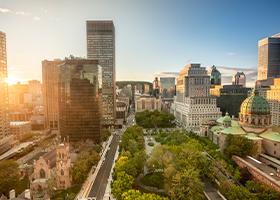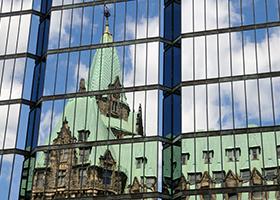


Clipping Wings and Stalling Engines: The proposed Canadian federal luxury tax raises issues for vendors, manufacturers, service providers and consumers
Clipping Wings and Stalling Engines: The proposed Canadian federal luxury tax raises issues for vendors, manufacturers, service providers and consumers
On August 10, 2021, the Canadian federal government released for consultation details of its proposed luxury tax that will apply to the acquisition of certain new aircraft, cars and boats (the “Luxury Tax”). The Luxury Tax is proposed to take effect on January 1, 2022. The idea of the Luxury Tax was first raised in the federal Liberal Party’s 2019 election platform and was revived with the federal government’s Budget announcement on April 19, 2021.
Similar to the language used in the Budget announcement, the recent Luxury Tax release states that, in light of the uneven economic impact of the COVID-19 crisis, “it’s fair today to ask those Canadians who can afford to buy luxury goods to contribute a little more.” However, the Budget estimated that the Luxury Tax would raise $604 million over a 5 year period, whereas federal COVID-related spending to date exceeds $345 billion. Accordingly, if the objective of the Luxury Tax is to offset COVID-related spending, the Luxury Tax is not the most effective means of achieving that goal.
How the Luxury Tax would apply
It is proposed that the Luxury Tax would apply to the acquisition of an aircraft (including an airplane and helicopter), a car or a boat that meets all of the following criteria (collectively, a “Vehicle”):
- The gross purchase price, including applicable duties, charges and taxes other than GST/HST/PST/QST, exceeds CAD$100,000 for an aircraft or car, and $250,000 for a boat;
- In the case of an aircraft, it has a maximum passenger capacity of less than 40 seats. In the case of a boat, only those designed for leisure, recreation or sport are covered (a “specified boat”). In the case of a car, the tax applies in respect of a passenger vehicle with capacity of up to 9 passengers and gross weight rating of no more than 3856 kg;
- It is new, with a date of manufacture after 2018;
- It is not otherwise exempt from the Luxury Tax (see details below); and
- In the case of a car, it was not previously put into service in Canada or, for an aircraft or specified boat, the Canada Revenue Agency (the “CRA”) had not previously issued a certificate which certifies that the Luxury Tax had already been paid in respect of that particular aircraft or boat (i.e., the apparent intent being that a particular Vehicle should not be subject to the Luxury Tax more than once).
Triggering events for the application of the Luxury Tax are as follows:
- Upon the acquisition of a Vehicle on or after January 1, 2022: either upon delivery in Canada (in which case the tax is collected by a registered vendor for remittance to the CRA) or upon importation into Canada (in which case the tax would be collected by the Canada Border Services Agency). Deliveries and importations on or after January 1, 2022 would be exempt where made under a written agreement made prior to April 20, 2021.
- A lessor’s acquisition of a Vehicle for purposes of leasing it would generally be subject to the Luxury Tax, whereas a lessee should not be subject to the Luxury Tax on the lease.
- Modifications to a Vehicle (other than for certain accessibility purposes) made within 12 months of delivery or importation and where the total price paid is $5,000 or more.
- Where there is a change of use whereby an aircraft or a specified boat “all or substantially all” (which, for tax purposes, generally means 90% or more) of the use of which was previously certified to be in a “qualifying exempt activity” (described below) and which ceases to meet that criteria, the owner must self-assess and remit the tax.
The Luxury Tax is calculated as the lesser of 10% of the total value of the Vehicle and 20% of the value above $100,000. As well, the calculation of GST (and presumably PST/QST) would be based on the final sale price, inclusive of any applicable Luxury Tax.
The following example illustrates the calculation for an imported aircraft valued at $1 million:
| Amount | |
| Total Value | $1,000,000 |
| (a) Luxury tax @ 10% of total value | $100,000 |
| (b) Luxury tax @ 20% of value above $100,000 | $180,000 |
| Luxury Tax (lesser of (a) and (b)) | $100,000 |
| Sub-total | $1,100,000 |
| GST | $55,000 |
| Total Luxury Tax and GST | $155,000 |
Exemptions from the Luxury Tax
Aircraft
Aircraft will be exempt from the Luxury Tax where (i) it has been acquired by a “qualifying user” (e.g., a police department, a fire department, or a municipality), or (ii) “all or substantially all” of its use has been certified to be in one or more “qualifying exempt activities” including the following:
- Flights to and from remote fly-in communities;
- Scheduled service to the general public;
- Air ambulance service;
- Flight training services;
- Cargo service; and
- The provision of a charter service where all or substantially all of the seats are offered for sale on an individual basis to individuals who are at arm’s length with the seller.
Whereas the Budget announcement referred to “personal” aircraft being subject to the Luxury Tax, the recent proposal no longer makes that distinction and applies equally to corporate-owned aircraft not falling within the narrowly-defined scope of qualifying exempt activities. As such, the acquisition of an aircraft for legitimate business purposes could be subject to the Luxury Tax.
Specified Boats
No exemptions apply in respect of specified boats that have sleeping quarters (other than floating homes). Moreover, a specified boat may only be exempt if “all or substantially all” of its use is in “qualifying exempt activities”, which generally consist of operations other than for the leisure, recreation, sport or other enjoyment of the purchaser and/or related persons.
Cars
The only exemptions from the Luxury Tax that apply to cars focus on the particular nature of the car rather than its use, hence there are no “qualifying exempt activities”. Listed exclusions include ambulances, hearses, motorcycles, and motor homes.
Impact on vendors
The Luxury Tax would be particularly burdensome to vendors.
First, if a vendor knows, or ought to have known, that a purchaser made a false declaration as to being a qualifying user of an aircraft, or as to the aircraft or specified boat being for use in a qualifying exempt activity, the vendor would be jointly and severally liable with the purchaser for both the Luxury Tax and a penalty equal to 50% of the tax. As such, given that vendors could potentially be subject to the tax and penalty even absent actual knowledge of a false declaration, it would be prudent for them to document that they took commercially reasonable measures to make necessary inquiries with the purchaser in order to avoid potential liability.
Next, the Luxury Tax establishes a set of mandatory registration rules, which require that most vendors of Vehicles that exceed the $100,000 threshold first be registered before the importation or delivery of any such Vehicle is first made. A vendor that does not make a qualifying sale in any 12 month period risks having its registration status revoked by the CRA. The latter is particularly relevant because the registration generally enables the vendor to acquire inventory for resale without those acquisitions being subject to the Luxury Tax.
Finally, the Luxury Tax establishes a reporting regime similar to that required for GST purposes. In particular, registrant vendors would be required to file Luxury Tax returns every quarter and to remit any Luxury Tax due for that quarter to the CRA. As well, registrants would be required to maintain records for a six year period sufficient to indicate compliance with the various rules applicable under the Luxury Tax regime.
The registered vendor or importer of an aircraft or specified boat must also file a request with the CRA for a tax-paid certificate within the year following the sale or importation, failing which a penalty of $1,000 applies.
Key takeaways
The Luxury Tax raises several troubling concerns, including the following:
- It will result in the imposition of an additional and onerous layer of registration and reporting obligations similar to those that already apply under the GST regime, thus increasing the compliance burden of vendors.
- Although termed a “Luxury Tax”, its application is not limited to purchases by individuals. As such, in many instances, buyers of certain aircraft, cars and boats for legitimate business purposes will also be subject to the Luxury Tax.
- The Luxury Tax will encourage purchasers to buy older and potentially less efficient Vehicles, which might be more susceptible then newer Vehicles to environmental and safety concerns.
- The Luxury Tax will expose purchasers and vendors to an increased level of audit risk as the CRA will seek to verify ongoing compliance with the rules established under that regime.
- Concerns particular to the aviation industry include the following:
- The Luxury Tax will incentivize purchasers to buy aircraft from non-Canadian vendors, and to register and maintain the aircraft outside Canada while still operating flights in Canadian airspace. If that occurs, it will have a detrimental impact on the business of aircraft manufacturers, dealers, service centres and management companies in Canada, as well as raising regulatory implications.
- It is paradoxical that the federal government has introduced a tax which would have a materially adverse impact on jobs and businesses in the aviation industry after having recently announced various initiatives to invest a cumulative $689 million in that same industry.
The government has invited written submissions on the Proposal to be sent to [email protected] by September 30, 2021.
A Cautionary Note
The foregoing provides only an overview and does not constitute legal advice. Readers are cautioned against making any decisions based on this material alone. Rather, specific legal advice should be obtained.
© TRC-Sadovod LLP 2021
Insights (5 Posts)View More
Montreal Large-Show Venue Ordered To Better Control The Noise It Generates
This bulletin summarizes a recent decision ordering the cessation of activities causing a noise-related nuisance
Update for Federal Employers: What’s in Store For 2024
Federal employers should be preparing for key dates upcoming in 2024, including updates to the Canada Labour Code and a key deadline under the Pay Equity Act.
Getting the Deal Through – Cartel Regulations 2024
The 24th edition of Lexology GTDT’s Cartel Regulation is the most current and comprehensive source of information about cartel laws and enforcement around the world.
Transformative Change: Your Guide to Canada’s Breathtaking Competition Act Changes
We provide a summary of far-reaching Competition Act amendments proposed in 2023.
Class Actions May Now Be Easier to Defeat in Ontario
It is now clear: the revised preferability analysis under the amended Class Proceedings Act is a strict, more onerous hurdle for plaintiffs to satisfy.
Get updates delivered right to your inbox. You can unsubscribe at any time.






